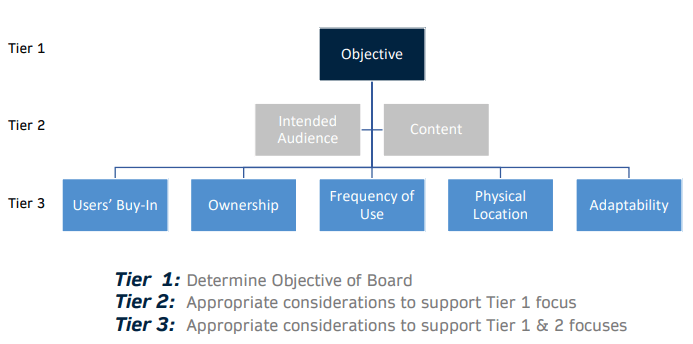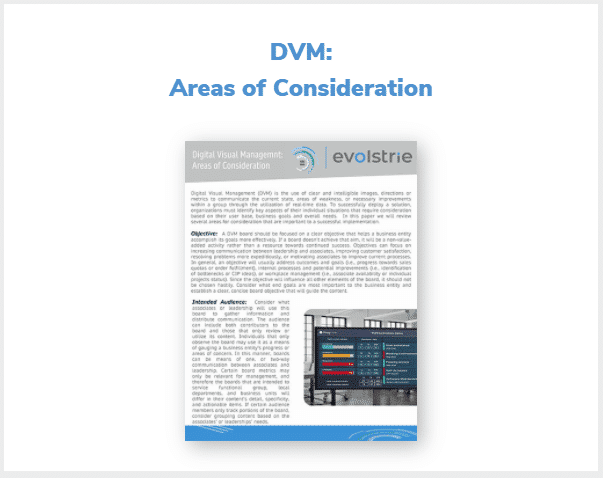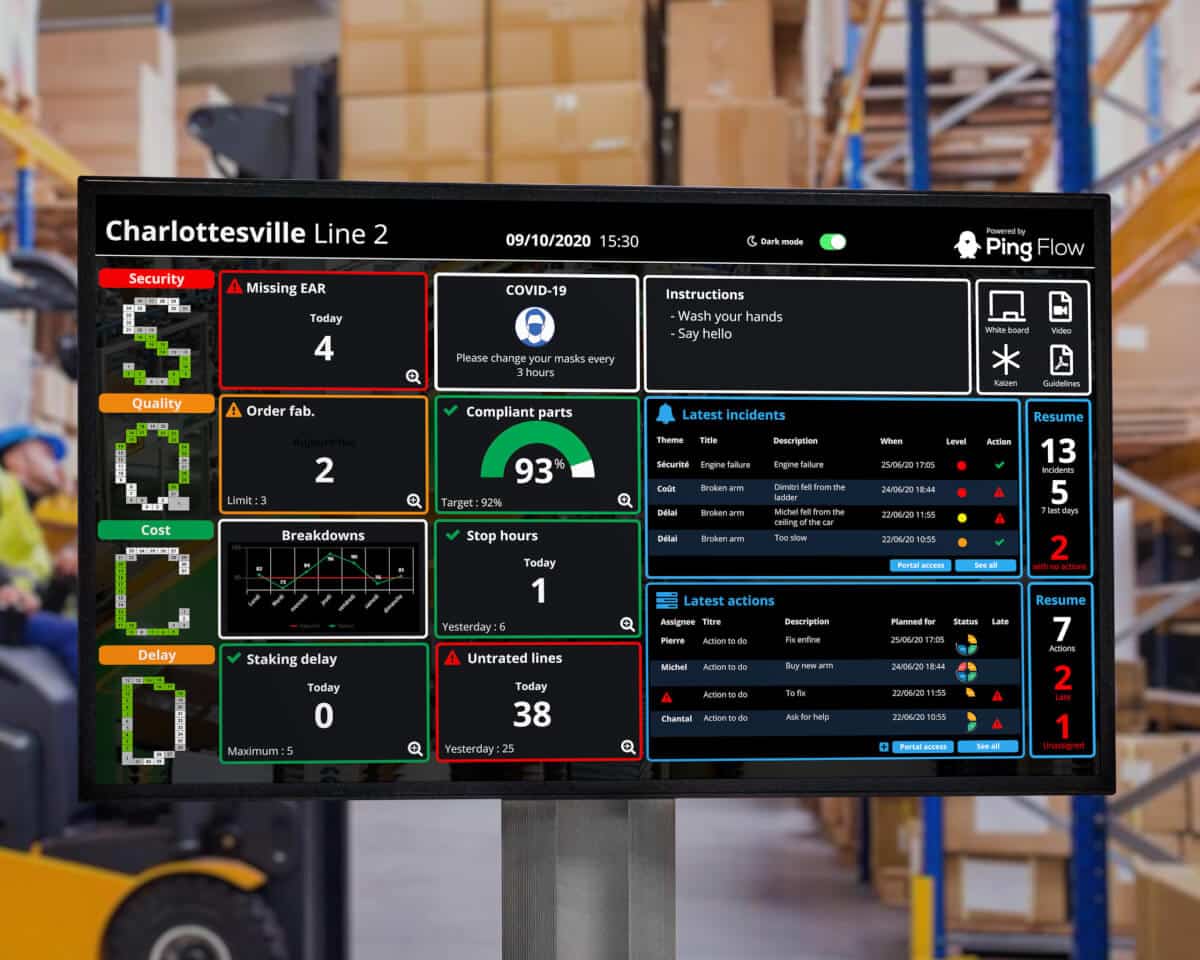Digital Visual Management (DVM) is the use of clear and intelligible images, directions or metrics to communicate the current state, areas of weakness, or necessary improvements within a group through the utilization of real-time data. To successfully deploy a solution, organizations must identify key aspects of their individual situations that require consideration based on their user base, business goals and overall needs. In this paper we will review several areas for consideration that are important to a successful implementation.
Objective
A DVM board should be focused on a clear objective that helps a business entity accomplish its goals more effectively. If a board doesn’t achieve that aim, it will be a non-valueadded activity rather than a resource towards continued success. Objectives can focus on increasing communication between leadership and associates, improving customer satisfaction, resolving problems more expeditiously, or motivating associates to improve current processes. In general, an objective will usually address outcomes and goals (i.e., progress towards sales quotas or order fulfillment), internal processes and potential improvements (i.e., identification of bottlenecks or CIP ideas), or workplace management (i.e., associate availability or individual projects status). Since the objective will influence all other elements of the board, it should not be chosen hastily. Consider what end goals are most important to the business entity and establish a clear, concise board objective that will guide the content.
Intended audience
Consider what associates or leadership will use this board to gather information and
distribute communication. The audience can include both contributors to the board and those that only review or utilize its content. Individuals that only observe the board may use it as a means of gauging a business entity’s progress or areas of concern. In this manner, boards can be means of one, or two-way communication between associates and leadership. Certain board metrics may only be relevant for management, and therefore the boards that are intended to service functional group, local departments, and business units will differ in their content’s detail, specificity, and actionable items. If certain audience members only track portions of the board, consider grouping content based on the associates’ or leaderships’ needs.
Content
The content of the board must be appropriate for the objective and intended audience. When the material is relevant and helpful in reaching the group’s assigned goals, the board will become an integral part of regular communication and daily work. Content should drive the audience towards action that supports the objective and ultimate business entity goals. This could be in the form of tracking monthly progress towards specific KPIs, drawing attention to specific issues and areas of deviation such as customer complaints, or highlighting what areas of improvements are being targeted. Select content or metrics that addresses the audience’s needs and are realistic for the users to provide on a regular basis. The content should drive its users and contributors to specific action, however, be aware that the quality of the content is highly affected by the level of users’ support and buy-in.
Users’ Buy-In
For a board to be successful in the long term, the entire business entity involved needs to champion its use. Stakeholders and associates that will be interacting with the board should be involved in the early development stages. Those responsible for initiating a board must be open to suggestions, feedback, and varying points of view; be wary of instituting a solution without consulting all the parties that will need to contribute time and material. Once the objective, audience, and content are determined, meet with the relevant parties to determine how the metrics can best be displayed and what other areas will be relevant to include. Having multiple contributors will help create a board that is more representative of the business entity’s focus. When individuals have provided input for the tool, they will be more vested in its success and use.
Ownership
Boards can often fall out of use and become outdated if a specific individual or group of individuals is not responsible for the routine maintenance and updating of the board. Consider appointing an individual champion who will oversea the board’s use, schedule updates, and support its overall objective. Each content piece can be assigned to a different associate; however clear instructions and expectations for board maintenance should be communicated and recorded to ensure that the board does not become outdated. Content will often drive areas of board ownership as certain associates may already be responsible for certain reports or data in their daily work. Individuals responsible for maintaining the various board elements board should be consulted in the initial ideation and development steps; they will be able to provide useful thoughts on the time needed to maintain the board and its frequency of use.
Frequency of use
The intended audience and content of the board will strongly dictate its frequency of use. Boards intended to capture and communicate sudden deviations will be used more frequently that one displaying the status of annual targets. When boards include content that is covered in routine meetings, groups can often reduce total meeting time and make board an integral part of standing meetings. Consider how frequently the selected content should be reviewed and attempt to keep meetings brief and routine. If the board will also be used outside of currently scheduled meetings, find ways to encouraging participation based on the unique group dynamic. This could be in the form placing the board in common lobby areas where the group members may gravitate.
Physical location
When selecting a physical location for the board, consider not only the space requirements in terms of the board’s size, but how many people will likely participate in each of the board meetings. While visibility to other departments and groups is helpful to promote activities and improvements, try not to place a board in an area where foot traffic could distract from or potentially lengthen a meeting in front of the board. The public use and display of the board should signal that it and its content are important. The objective of the board will strongly influence the location. Boards aimed to increase awareness and communication amongst business entities should be displayed in areas with broad associate exposure. However, also consider the content of the board, and whether any details therein should not be disclosed to other groups or visitors; generally confidential information should not be displayed publicly.
Adaptability
After a board has been launched, review meetings should be scheduled to assess the tools effectiveness and how well the current solution is helping the business entity align to its goals. This check is important to ensure an ineffective, stagnant board does not persist too long in a business entity and thereby negatively affect the group morale. Board initiators should not become emotionally invested in an initial plan of action but should earnestly seek feedback to support the board’s continued use and longevity. Additionally, consider how likely the business entity’s goals are to change in the future. If that is likely, consider how the board might be able to adapt accordingly.
Decision Hierarchy
The above areas of consideration are highly dependent upon one another and should all work to support the board’s overall objective. While every board will differ in its execution, the decision hierarchy below provides a recommended decision-making order when planning a DVM solution.

Conclusion
Given each business entity’s unique goals and challenges, the elements and use of their respective DVM boards can vary greatly. There should not be a push for an organizational standard template to visualize every business entity’s status; rather each should use the methods that allow them to best display information that aids the team in reaching its targets and delivering on its KPIs.
As a business entity grows and adapts, its challenges and objective will change as well. DVM boards should allow for necessary modifications and be amended so as to align with current needs and goals.
by Wes Bodenhamer – managing director Evolstrie
Premier Partner of PingFlow in the USA
Download the PDF :




